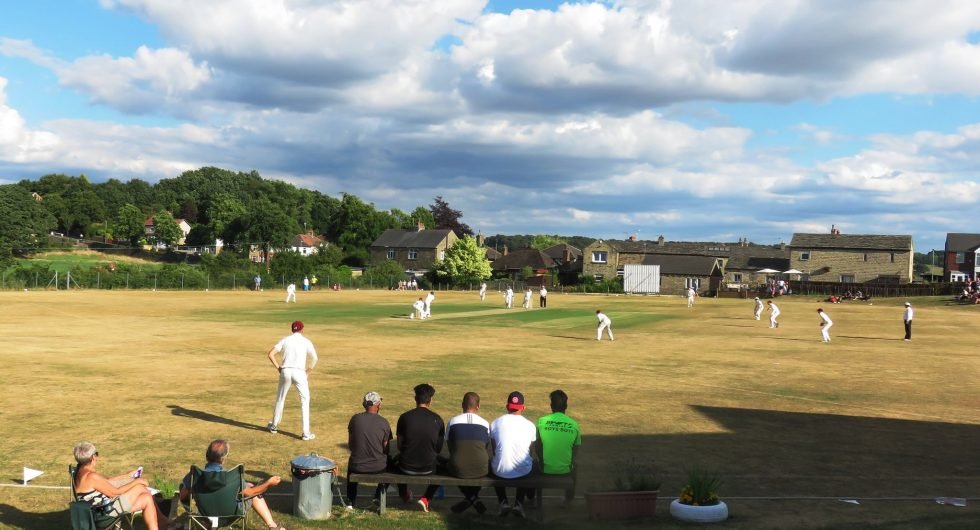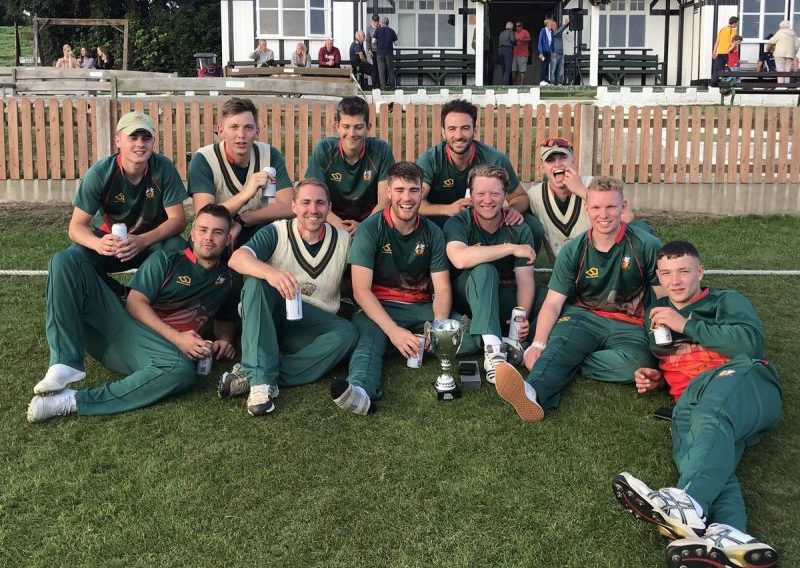Fit, available, keen, not banned… but ineligible by league rules

 by Scott Oliver
by Scott Oliver
@reverse_sweeper 12 minute read
Lead image: Mike Latham
With participation numbers down in recreational cricket, one league’s eligibility regulations are stopping healthy, available, keen cricketers from playing the game they love. Scott Oliver investigates.
Participation. It’s a word that’s never far from the thoughts of administrators, the sort of word likely to appear first on whiteboards (triple underlined) when they gather round tables to discuss the game’s problems and its future. Be it among professionals in the upper echelons of the ECB or volunteers at grassroots level, the widely reported issue of declining participation – people walking away from the game younger or else not taking it up at all – and how to address it is a common, central preoccupation.
For better or for worse, it is the animus behind next summer’s inaugural The Hundred competition, the stated aim of which is to reach out beyond “cricket’s traditional audience” – or “traditional cricket’s audience” – and attract more hearts and minds to the game. It is the raison d’être of admirable initiatives such as the Chance to Shine charity, which take cricket to as many corners of the country as possible. Occasionally, though, for all its proselytising efforts and missionary zeal, cricket shoots itself square in the foot.

Pursell (fourth from left, bottom row) with the rest of his Stone teammates
Take the case of Adam Pursell, a 22-year-old Loughborough University student who plays as a leg-spinner for Stone SP in the North Staffordshire and South Cheshire League (NSSCL). Pursell has had two knee operations in the last two years, causing him to miss the whole of the 2018 season and the start of this, yet earlier this year – the day England won the World Cup, in fact – he took 4-3 and 5-24 to be named Man of the Finals Day as Stone won the NSSCL’s T20 competition. Roll forward eight weeks to last Saturday, however, and Pursell, despite being fit, available, keen to play and not subject to any disciplinary ban, was forced to sit out the weekend’s NSSCL matches.
The reason he couldn’t take the field was a well-intentioned but ultimately ludicrous, counter-productive and self-harming NSSCL eligibility ruling, which states: “for the last three games of the season, any player who has played 50 per cent or more of their available matches for a higher ranked team will be ineligible to play for any lower-ranked team unless the player has played his previous four matches for that lower-ranked team or clearance is sought from the League Manager”.
After Pursell’s return, in June, from a season-and-a-half injury lay-off, he played three league games in the second team then five in the firsts, before sitting out three weeks to address issues with his bothersome knees, declining to play in the seconds as a batsman, which would have taken him to 5/6 and rendered him available for both teams, albeit at the risk of aggravating the injury. And then the ‘eligibility endzone’ arrived: Week 20 of 22. “I wasn’t expecting to have been thrown back into the first team, in all honesty, considering the amount of cricket I’ve missed the last few years” he says. “But being unable to drop down meant there wasn’t a place for me in the sides this week”.
Not just this week. He is effectively trapped in his ineligibility for the final three weeks, unless the club specifically tweak selection to get him a first-team game. Had he played a couple of those second-team games and been 5/5, exactly 50 per cent, the situation would have been even more absurdly Catch-22: in order to adjust his appearance percentage and become eligible for the seconds, he would need to play a game for them; but because of his appearance percentage, he was disbarred from playing the game that would have made him eligible. It is all worthy of a Franz Kafka novel. But in order to understand how such a preposterous state of affairs came to pass, we must first take a brief historical detour.
***
The NSSCL was formed in 1963 by a breakaway of 12 leading clubs from the much older North Staffs and District League. These clubs competed in one division, with a parallel division for their second teams. Promotion and relegation entered the picture when the league expanded to two divisions in 1981 (1A and 1B, with 2A and 2B for the second XIs) and then to four – or 48 clubs – in 2006. However, throughout this period, the fates of the second XIs were pegged to the fortunes of their respective first teams, meaning that if, say, a club’s first XI finished bottom of 1A while its seconds topped 1B, the latter would not go up to Premier B but follow the first team through the trapdoor and into Division 2. Harsh, but unavoidable given the complications of compiling a rational, symmetrical fixture list (first XI and second XI playing the same club, home and away, each week).
However, toward the end of the 2000s the wider societal forces causing the drop-off in participation started to bite. Spots began to open up in Division 3A as struggling clubs folded, downsized or simply merged with bigger clubs. The NSSCL’s response was to invite a few clubs with large playing memberships and the capability of putting out four senior sides to enter ‘A’ teams – effectively a second first XI, although in reality the club’s second team – to compete in 3A, with a second club pro if they so desired, thus ensuring four divisions of twelve remained intact. This is where the issue of ‘selection manipulation’ first began to loom.
In order to ensure that clubs with ‘A’ teams couldn’t game the overall first XI competition by transferring resources from the first XI to ‘A’ team at the end of the season should favourable circumstances arise, these clubs were obliged, three times during the season, to designate seven ‘starred’ players for the next block of fixtures (seven, eight and seven games). This is where things became a little complicated. If, for some reason, a starred player lost form in the middle of a block, they couldn’t be dropped from the club’s best team (first XI) to its next best team (the ‘A’ team), but had to go to the third best team (called the second XI), in the first XI’s ‘shadow’ division (Premier B). These players were rarely happy about this, but with the promotion and relegation of teams in the B divisions still dictated by the first XI’s performance, the question of any manipulation in doing this was moot (in reality, it was quite. Clubs with just the usual first and second team carried on selecting as they always had done, with no restrictions on who played where.
So far, so sensible. But things became more complicated still a few years later when NSSCL decided to allow the second teams to fight for promotion in their own right, independently of their respective first XI’s performance – first restricting this to the B divisions, with a glass ceiling above the fifth tier, and then making it an open ladder of nine divisions. (This at least meant an end to the ‘A’ teams, an end to a nightmare of nomenclature whereby the firsts’ ‘seconds’ are really the thirds and the fourths are in fact the ‘A’ team’s seconds, which is to say the seconds of the seconds!)
Again, the logic behind this move to an open ladder was sound, in step with wider changing realities. For if a particularly strong club had a handful of ambitious cricketers in its second XI, under the old system they would have had a choice to make: stay at the club they considered home and wait for who knows how long for the opportunity to come up to challenge themselves at the higher standard (previously, always exactly four divisions higher) or leave their club in search of guaranteed first XI cricket elsewhere. By making the league an open ladder, a strong club’s second team could now push on up, and up, better satisfying the ambitious second teamer’s aspirations while also helping clubs to minimise churn, thus preserving their wider communities and with that their identities. So far, so visionary.
Now, however, it wasn’t only the clubs with ‘A’ teams that could potentially manipulate selection. It was all of them. And one or two of them did, causing the league to act. And so the eligibility regulations covering the final three weeks – drafted by the Cricket Committee without a formal vote on the wording – came into force at the start of last season.
Unfortunately, though, these two well-intentioned logics – one allowing second string or fringe players to progress and play an increasingly better standard while staying at their cherished clubs, creating a sense of social continuity and stability, the other preventing selection abuses within clubs that might compromise the integrity of competition – have started to chafe against each other, ultimately producing the wholly unsatisfactory and unsustainable outcome described above.
***
Which brings us back to Adam Pursell – not to mention other unfortunately ineligible NSSCL players – walking round the boundary in the gentle autumnal sun, ferrying drinks and jumpers to bowlers, outside looking in, a cheerleader and gopher instead of bowling leg-breaks at the sharp end of the season. “When you’ve missed the amount of cricket I have”, he says, “it’s always going to be frustrating [to be denied the chance to play]. Yes, I understand that I’m a first-team player, but I’ve barely played ten games in the last two years and had double knee surgery. I’d just like to be able to get on the field at any level”.
Truth was, Stone selected a player with only three first XI appearances, so there was, in theory, some scope to have given Pursell a game, although since the player who could have dropped down was a specialist batsman, whereas Pursell would normally bat in the lower order, doing that would have meant unbalancing the side – ironically, a ‘manipulation of selection’ that would compromise the integrity of the competition, but in a different way – all of which was unthinkable with the team not yet mathematically safe from relegation.
Indeed, Pursell didn’t really expect the club to compromise picking the best available team just to give him a game. “If you have important fixtures”, he says, admirably philosophical about it all, “you want to be able to select the best team for it, not be hampered by the fact you can’t drop a player who isn’t playing well because of an eligibility rule, or can’t promote somebody who is playing well in your seconds but then risk having to leave a first-team player out altogether as they can’t drop down a side”.
Pursell’s cricketing limbo is doubly frustrating for him given his lengthy injury absences. Not only that, however: while he’s a handy bowler with some first-team success, he’s still learning a difficult craft and is unlikely to have gone straight into Division 3 – where Stone second XI are in the promotion race – and dominated. Which is to say, it wouldn’t have raised eyebrows or been perceived as unfair advantage-seeking. Indeed, coming back after a spell on the sidelines and with two-finger spinners already in the Stone first XI, it’s probable he would have been selected in the second XI anyway. Instead, he was prevented from playing any cricket at all. This is not a good look for recreational cricket. Ever likely people are leaving the game.
Meanwhile, Stone’s opponents on the day, Moddershall & Oulton [full disclosure: my club], had eleven first XI players in the 50 per cent bracket – but this didn’t include their sub-professional, who they were very keen to have play with relegation still a possibility for them, too. So, four first-team players in the 50 per cent bracket were nominated to the league manager as possible omissions. They had one league wicket between them for the season, while their batting contributions across the campaign were: 96 runs at 12, 107 at 9.73, 72 at 9, and 130 at 11.82. Moving these players from Premier A to 3A would hardly have constituted ‘cheating’ or artificially strengthening the lower team. Nevertheless, the league manager refused to give clearance for any of them to move down, the net result of which was one of them would be spending his Saturday afternoon not playing the sport that they loved, the sport that they had paid subscription fees in order to play.
The player who missed out was Rob Spruce, who had been in the second XI the previous week (having lost his spot while away on his honeymoon), and so he went to work instead. On top of that, two promising under 16s who had recently forced their way into the first XI were also forcibly demoted to prevent another two players being rendered ineligible. Again, hardly picking your strongest available team.

Rob Spruce went to work after missing out
The league can always point to the “four previous games in the lower team” caveat, to better planning around selection, but this ignores the hurly-burly of club cricket. With fluctuating form and availability (which is only getting patchier as lifestyles and work patterns change), plus the chance that a majority of clubs will have multiple sides involved in promotion and/or relegation issues and thus lack the scope for ‘musical chairs’ selection, it would require a crystal ball to figure out, seven weeks from the end of the season, which of your current crop of 50 per cent-plus first-teamers may be surplus to requirements for the last three weeks and thus can be strategically dropped four weeks out from the ineligibility window becoming active. It is worth remembering at this point that we are talking about club cricket here.
And this regulation has the potential to beget even more bewildering and perverse scenarios. For instance, imagine a club that suffers a spate of injuries (and/or has a couple of players with limited availability) arriving at Week 20 with fifteen players over the 50 per cent threshold for the first XI. Having four ineligible players might then mean that teams lower down the club are playing with short numbers – eight, nine players – while, ludicrously, four fit and healthy players look on.
Ultimate responsibility for the regulation lies with the NSSCL Cricket Committee, since they were its authors. But it isn’t black and white; isn’t open and shut. There is, in the wording, latitude for the league manager to exercise some discretion and allow players to play. Perhaps understandably, however, given the scope for controversy and in the absence of a more robust framework in which he could exercise reasonable discretion without fear of blowback, the tendency would be to hide behind the letter of the first part of the regulation in order to protect oneself from the accusatory sniping of clubs minded to pore over your decisions for signs of perceived inconsistency or favouritism.
The NSSCL Manager, Keith Tunnicliffe, has not responded to a request for comment, although replying in writing to one club’s petition to move a 50 per center, he offers the following explanation: “I do not make the League Rules, but merely attempt to ensure that clubs abide by them when giving advice. It is common knowledge that I do not particularly agree with the rule in question, but I fully understand why it exists. There are several clubs in a similar situation to your club, and have the same problems selecting their teams for the next three weeks. I agree that it is most unfortunate if players have to miss a game of cricket at any time, let alone during the last three weeks of the season with a long break ahead. However, the rule has been included for a reason: to prevent clubs manipulating their selections to suit themselves OR influencing, directly or indirectly, the promotion and relegation issues within the various divisions of the league”.
This isn’t a problem unique to NSSCL. Similar scenarios have arisen in the Leicestershire & Rutland League, the Thames Valley League, the Hertfordshire League and others with an open ladder structure. But what is the solution, one that safeguards against cheating-by-selection and preserves the integrity of the competition without scoring such a catastrophic own goal?
Suggestions have included: the establishment of reciprocal independent panels with neighbouring leagues; allowing the currently ineligible player with the fewest first XI appearances (by percentage or gross) to drop down, then the next highest, and so on; applying reasonable statistical thresholds, so that players with numbers that don’t exactly scream ‘ringer!’ could move down in a way that, evidently, is not ‘abuse’ of the system; or perhaps each club could star seven ‘unmovable’ players who must remain in their designated teams over the final three weeks.
Anything that stops healthy, available, keen cricketers avoid the preposterous situation of being forced to sit out games at the end of the season, when the best experiences are often to be had, because of this self-defeating smallprint (and the suspicion that often comes with these hyper-competitive open-ladder structures) has to be better than the situation as it presently stands.
Read more club cricket stories

